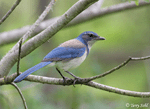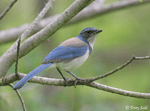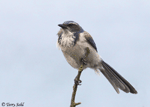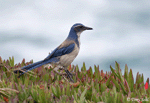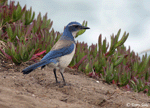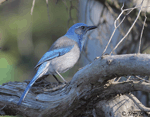| Length: 11.5 inches | Wingspan: 15.5 inches | Seasonality: Non-resident in South Dakota |
| ID Keys: Blue upperparts with grayish upper back, grayish underparts, white chin and eyebrow | ||
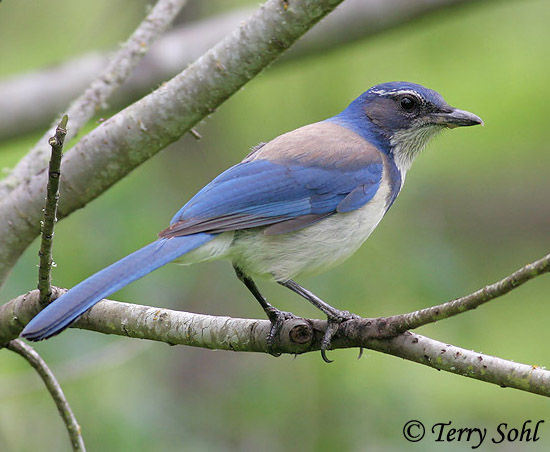 The
California Scrub-Jay was once considered a single species, along with what
is now Woodhouse's Scrub-Jay.
The two species were jointly called the "Western Scrub-Jay" until the
American Ornithological Union split the species in 2016. The
California Scrub Jay is found in states along the West Coast, and is
generally more richly colored than the similar Woodhouse's Scrub Jay.
Multiple other Scrub Jays were all once considered the same species,
including the Island Scrub-Jay and the
Florida Scrub-Jay. All of the
Scrub-Jays are a relatively common sight and
sound throughout much of the West, often seen conspicuously foraging in
suburban landscapes, or heard when giving their variable harsh calls.
The
California Scrub-Jay was once considered a single species, along with what
is now Woodhouse's Scrub-Jay.
The two species were jointly called the "Western Scrub-Jay" until the
American Ornithological Union split the species in 2016. The
California Scrub Jay is found in states along the West Coast, and is
generally more richly colored than the similar Woodhouse's Scrub Jay.
Multiple other Scrub Jays were all once considered the same species,
including the Island Scrub-Jay and the
Florida Scrub-Jay. All of the
Scrub-Jays are a relatively common sight and
sound throughout much of the West, often seen conspicuously foraging in
suburban landscapes, or heard when giving their variable harsh calls.
Habitat: California Scrub-Jays can be found in a variety of shrubby and brushy habitats. They typically live near oak woodlands and scrubby chapparal, as well as brushy suburban habitats.
Diet: Omnivorous, feeding a wide variety of plant and animal matter. California Scrub-Jays feed heavily on sects and spiders during the summer months, while the winter diet often consists of more plant material, including seeds, acorns, fruits, and berries. They will also take small reptiles, amphibians, young birds, eggs, and small rodents when the opportunity arises.
Behavior: During the breeding season, California Scrub-Jays normally are found as isolated breeding pairs, and will vigorously defend territories from other Scrub-Jays. Outside of the breeding season, they are often found foraging in small family groups or small flocks. Mated pairs typically stay together throughout the year.
Nesting: Both the male and female help build a cup-shaped nest of sticks, plant material, and moss, usually relatively low in a tree or shrub. The female incubates the eggs, with the male feeding her during incubation. Both species will help feed and tend to the young.
Song: Utters a variety of rather harsh-sounding calls.
Migration: Considered permanent residents throughout their range, although there is some dispersal of birds in years of scarce food supplied in normal locations.
Interactive eBird map: Click here to access an interactive ebird map of Calfornia Scrub Jay sightings
Feeders: Will sometimes attend feeders for nuts and seeds. Can often be found in suburban areas, hunting for insects, as well as for fruits and berries in suburban landscaping.
Similar Species: Closely related and similar to Island Scrub-Jay, Florida Scrub-Jay, and Woodhouse's Scrub Jay, all of which were once considered one species. Also similar to Pinyon Jay and Mexican Jay.
Conservation Status: There are currently no perceived major threats to California Scrub-Jay populations, and Birdlife International cites it as a species of "Least Concern".
Further Information: 1) WhatBird - California Scrub Jay
2) Wikipedia - California Scrub Jay
3) Audubon Guide - California Scrub Jay
Photo Information: April 19th, 2007 - Point Reyes National Seashore, California - Terry Sohl
| Click below for a higher-resolution map |
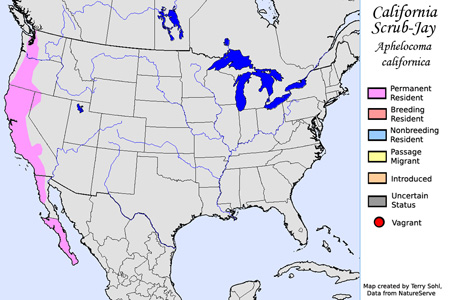 |
| South Dakota Status: Non-resident in South Dakota |
Additional California Scrub-Jay Photos
Click for a higher-resolution version of these photos
